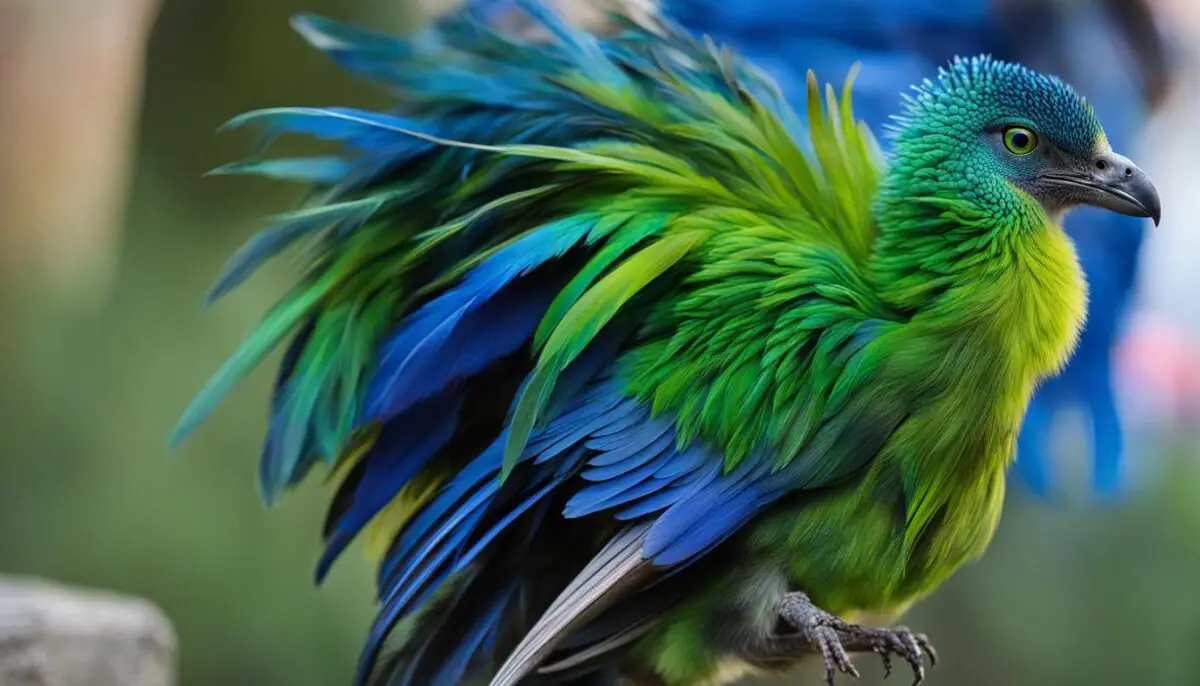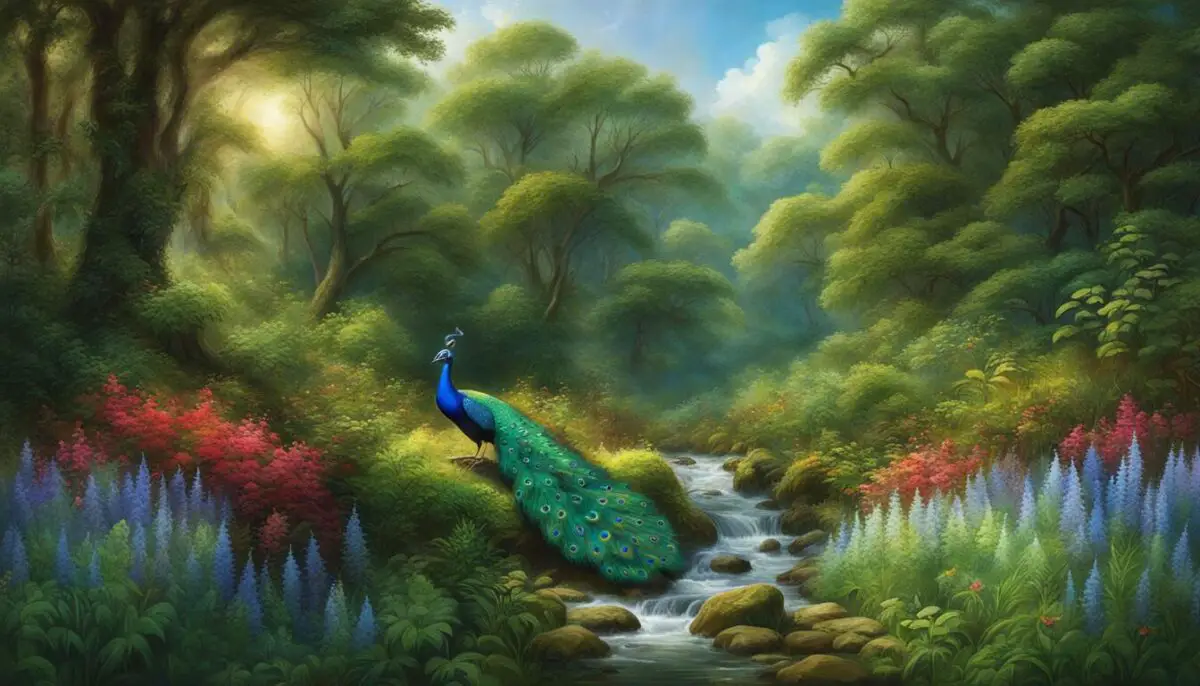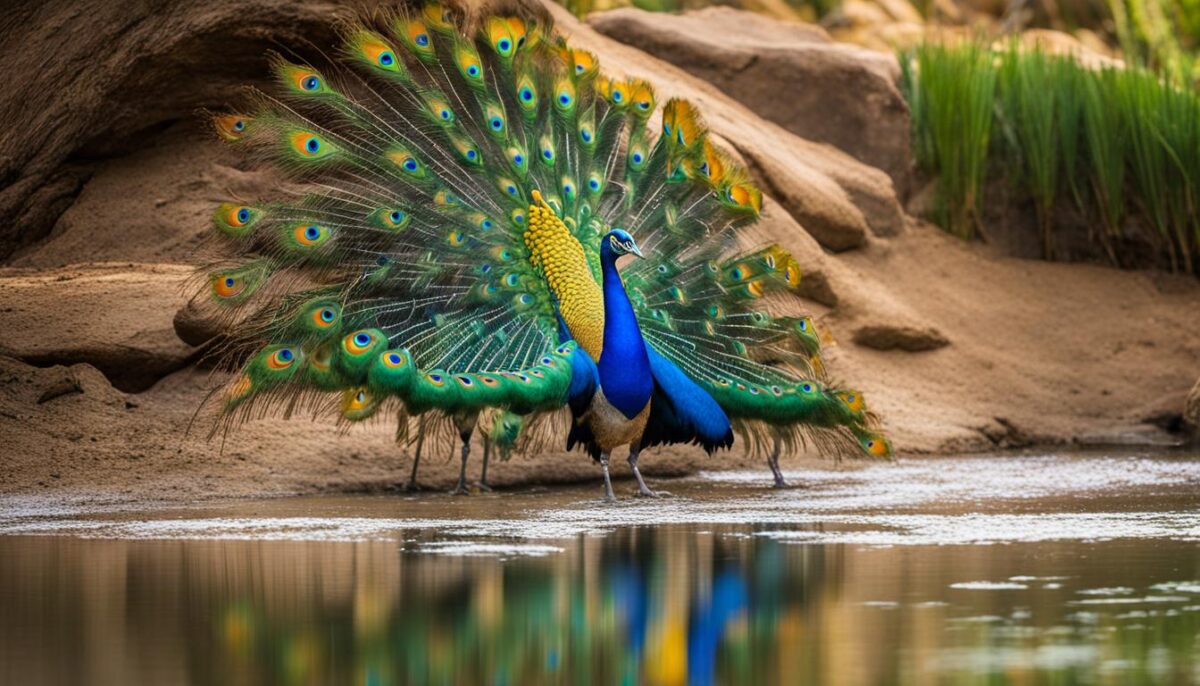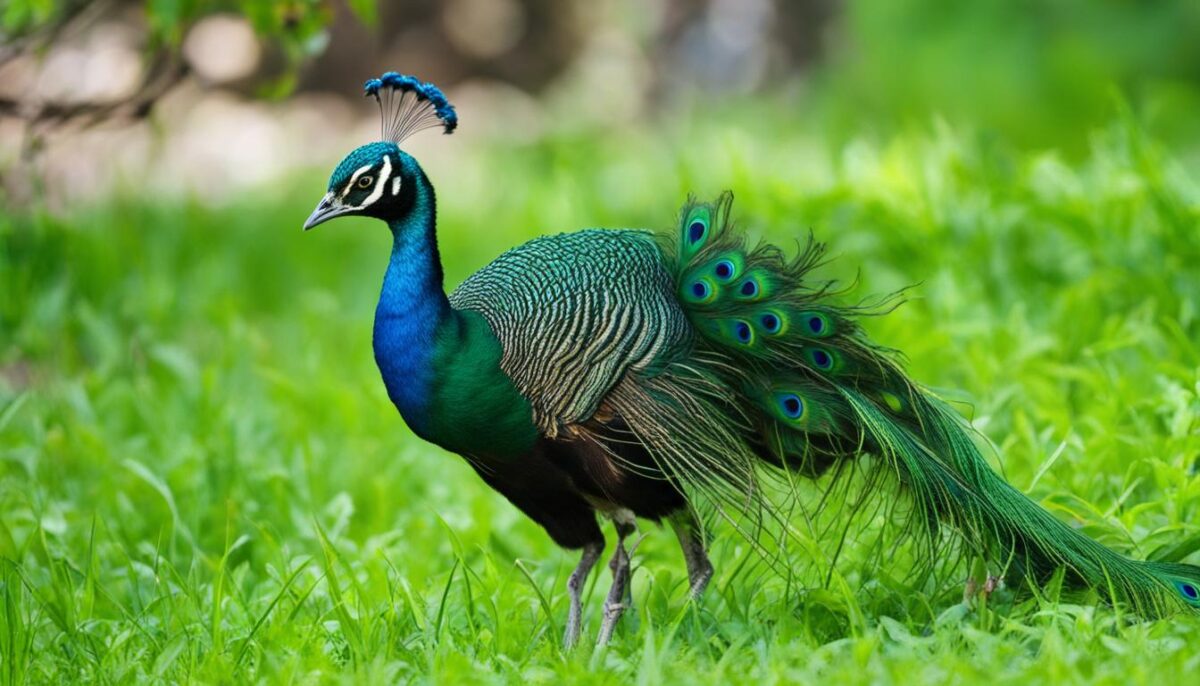When it comes to the magnificent peacock, we often picture its dazzling array of colors and intricate patterns. But have you ever wondered what a baby peacock looks like? In this article, we will explore the appearance and physical characteristics of these adorable creatures as they begin their journey towards adulthood.
Key Takeaways:
- A baby peacock, or peachick, starts off with a less eye-catching appearance compared to its adult counterpart.
- The peachick has a yellowish to light brown coloration to help it blend in with its surroundings.
- It has a rounded head, open eyes, a stocky body, and long, strong legs.
- After about four weeks, the peachick begins to grow its trademark crests, and male chicks start growing their tails.
- However, it takes several months for the peachick to fully resemble its adult parent.
If you’ve ever been curious about the journey of a baby peacock and how it transforms into the majestic bird we know, keep reading to unravel the wonders of nature’s beauty.
Peacock Nesting
During the breeding season, which typically occurs during the monsoons, peacocks engage in the fascinating process of nesting. It is the female peafowl, known as the peahen, who takes charge of this crucial task. She carefully selects a suitable site for her nest, usually on the ground, where she creates a shallow depression in the soil. To ensure the nest is comfortable and well-insulated, the peahen lines it with vegetation.
Once the nest is ready, the peahen lays an average of 3 to 8 light green or tan eggs. These precious eggs are then incubated solely by the peahen for about a month. The peahen dutifully maintains the temperature and humidity levels required for the eggs to develop and hatch successfully.
“The peahen’s commitment to incubation is truly remarkable. She diligently protects her eggs from predators and other threats while providing them with the nurturing environment they need to thrive.” – Dr. Avian Researcher
As the days pass, it is truly a sight to behold when the peachicks finally emerge from their eggs, bringing new life and beauty to the world. The journey of peacock nesting showcases the dedication and resilience of these magnificent birds in ensuring the survival of their species.
| Peacock Nesting | |
|---|---|
| Relevant Information | Details |
| Nesting Season | Breeding season, typically during the monsoons |
| Nest Construction | Peahen creates a shallow depression in the soil and lines it with vegetation |
| Egg Color | Light green or tan |
| Incubation Period | Around a month |
| Incubation Responsibility | Peahen exclusively incubates the eggs |
| Chick Appearance | Peachicks finally emerge from the eggs |
The nesting process of peacocks is a testament to the remarkable instincts and behaviors that occur in the natural world. It is a reminder of the extraordinary lengths that animals go to ensure the survival of their offspring. By understanding and appreciating the intricacies of peacock nesting, we gain a deeper insight into the wonders of nature and the incredible biodiversity that surrounds us.
How To Tell Baby Peacocks Apart?
Identifying baby peacocks can be a fascinating task, as they go through significant changes in appearance as they grow. While they may bear some resemblance to baby pheasants, there are distinguishing features that set them apart. Here are some key characteristics to look out for:
- Coloration: Baby peacocks have a lighter coloration compared to baby pheasants. They typically exhibit a yellowish-brown hue, which helps them blend into their surroundings.
- Contrasting Streaks: Unlike baby pheasants, baby peacocks do not have contrasting streaks on their feathers.
- Crests: Male peacock chicks start developing their trademark crests after about two months. These crests are absent in baby pheasants.
As baby peacocks continue to grow, male chicks gradually begin to resemble the peahen in size. They undergo a transformation that includes the growth of their iconic tails, which distinguishes them even further from baby pheasants.
Observing these characteristics and changes can help in accurately identifying baby peacocks and distinguishing them from other bird species.

Table: Comparing Baby Peacocks and Baby Pheasants
| Characteristics | Baby Peacocks | Baby Pheasants |
|---|---|---|
| Coloration | Lighter (yellowish-brown) | Darker (varies based on species) |
| Contrasting Streaks | Absent | Present |
| Crests | Develops in male chicks | Absent |
| Tail Growth | Gradually grows into majestic tails | Absent |
What Do Baby Peacocks Eat?
Baby peacocks, like their adult counterparts, have an omnivorous diet that allows them to consume a wide variety of foods. During the early stages of their life, baby peacocks primarily rely on insects as a source of protein. They forage and hunt for small insects and other invertebrates to fuel their growing bodies. Insects such as crickets, ants, beetles, and caterpillars are among their favorite prey.
As baby peacocks continue to mature, their diet expands to include grains, seeds, and berries. They develop a preference for small grains like rice and wheat, which provide them with carbohydrates for energy. Additionally, they enjoy feasting on a variety of seeds and berries found in their natural habitat. This diverse diet helps to supplement their nutritional needs and encourages healthy growth.
It is important to note that while baby peacocks eat a range of foods, they still require a sufficient amount of protein for proper development. Protein-rich food sources for baby peacocks include small animals like lizards, worms, and even small rodents. These sources of animal protein provide the essential amino acids necessary for their muscle development and overall health.
| Type of Food | Examples |
|---|---|
| Insects | Crickets, ants, beetles, caterpillars |
| Grains | Rice, wheat |
| Seeds | Sunflower seeds, pumpkin seeds |
| Berries | Blueberries, raspberries |
| Animal Protein | Lizards, worms, small rodents |
Providing a balanced diet for baby peacocks is essential for their overall health and growth. It is recommended to offer a variety of foods that mimic their natural diet in the wild. This can include a combination of small insects, grains, seeds, berries, and occasional sources of animal protein. Ensuring that they have access to fresh water is also crucial for their hydration needs.
Baby Peacocks: Frequently Asked Questions
Here are some common questions people have about baby peacocks:
- What does a baby peacock look like?
- How do you tell if a baby peacock is male or female?
- How long does a baby peacock stay with its mother?
- What do baby peacocks need?
- What is the lifespan of a baby peacock?
A baby peacock, known as a peachick, has a yellowish-brown coloration, rounded head, stocky body, and strong legs. They blend in with their surroundings and take several months to resemble their adult parents fully.
Male baby peacocks begin to develop crests and grow tails as they mature. Female chicks retain a similar appearance to their mother. Their gender becomes more distinguishable as they continue to grow.
Baby peacocks commonly stay with their mothers for about four months. During this time, the mother provides protection, guidance, and social interaction, which are essential for their healthy development.
Proper care for baby peacocks includes a spacious and clean environment, appropriate food and water, protection from drafts and direct sunlight, and opportunities for social interaction. These factors contribute to their overall well-being and growth.
The lifespan of a baby peacock, or peachick, can vary depending on various factors such as predation, disease, and habitat conditions. In the wild, peafowls live around 10 to 25 years, while domesticated peafowls can live up to 40 to 50 years with proper care and maintenance.
By understanding and addressing these frequently asked questions, individuals can gain valuable insights into the appearance, gender identification, care needs, and lifespan of baby peacocks.
The Beauty of Peafowl
Peafowl, including the Indian and Javanese species, are truly a sight to behold. They are renowned for their stunning beauty, with their vibrant feathers capturing the attention of all who encounter them. The males, in particular, possess a mesmerizing array of colors and patterns that make them stand out among other birds.
The most striking feature of male peafowl is their long, iridescent tails adorned with eye-like patterns. These magnificent feather displays are used during courtship to attract females. The tails can measure up to 6 feet in length and are a breathtaking sight when fully fanned out. The rich hues of blues, greens, and bronzes in their plumage create a dazzling spectacle, making them one of the most visually appealing creatures in the avian kingdom.
While the males steal the show with their flamboyant plumage, female peafowl also exhibit their own understated beauty. They possess a more subdued coloration, including shades of brown and gray, allowing them to blend into their natural surroundings for camouflage and protection.
| Feature | Male Peafowl | Female Peafowl |
|---|---|---|
| Plumage | Vibrant, iridescent colors | Subdued, earth tones |
| Tail Length | Up to 6 feet | N/A |
| Feather Patterns | Eye-like patterns | N/A |
The beauty of peafowl is not only admired by humans but also plays a crucial role in their survival. The elaborate courtship displays performed by males demonstrate their fitness and genetic quality, while the females carefully select their mates based on these displays. The vibrant feathers of peafowl are a testament to the wonders of nature and remind us of the incredible diversity and splendor found in the animal kingdom.
Size and Weight of Peafowl
Peafowl, which includes both the male peacock and the female peahen, differ in size and weight. The size and weight variations between the male and female peafowl are quite noticeable. Let’s take a closer look at the dimensions of each:
| Length (inches) | Wingspan (inches) | Weight (pounds) | |
|---|---|---|---|
| Female Peafowl (Peahen) | 35 – 43 | 31 – 51 | 6 – 8.8 |
| Male Peafowl (Peacock) | 70 – 98 | 51 – 63 | 8 – 13 |
As seen in the table above, female peafowl are generally smaller than their male counterparts. Female peahens measure between 35 and 43 inches in length, with a wingspan of 31 to 51 inches. They weigh between 6 and 8.8 pounds. On the other hand, male peacocks are larger and more majestic. They measure approximately 70 to 98 inches in length, with a wingspan of 51 to 63 inches. Male peacocks weigh between 8 and 13 pounds, making them significantly heavier than females.
These size and weight differences play a crucial role in the peafowl’s physical appearance and behavior, with male peacocks showcasing their impressive size and vibrant plumage during courtship displays to attract females. The larger size and weight of male peafowl contribute to their ability to carry and display their elaborate trains of feathers, a characteristic that distinguishes them from their female counterparts.
“The male peacock’s large size and weight are vital for displaying its extravagant plumage, playing a vital role in attracting potential mates during courtship displays.”
Understanding the size and weight differences between male and female peafowl allows us to appreciate the remarkable adaptations and evolutionary traits of these captivating birds. These variations not only contribute to their visual appeal but also play a crucial role in their reproductive behavior and survival in their natural habitats.
Habitat and Geography of Peafowl
Peafowl, which includes the blue and green species, are native to the open lowland forests, farms, and agricultural fields of South and Southeast Asia. The blue peacock (Pavo cristatus) is found in India and Sri Lanka, while the green peacock (Pavo muticus) has a range that stretches from Myanmar to Java. Additionally, the Congo peacock (Afropavo congensis) is native to the forested interior of the Democratic Republic of the Congo.
These stunning birds thrive in diverse habitats, from the lush rainforests of Southeast Asia to the drier woodlands and savannahs of India. They are well-adapted to their surroundings and can be found in both natural and cultivated landscapes, making them a common sight in rural areas.
Habitat
The peafowl’s habitat consists of a mixture of forest edges, grasslands, and agricultural fields. They have also adapted well to human-altered landscapes, often venturing into gardens and residential areas in search of food and shelter. The open lowland forests provide them with ample foraging opportunities, as they feed on a variety of insects, small animals, grains, seeds, and berries in their habitat.
Their ability to thrive in different habitats has contributed to their widespread distribution across Asia. However, habitat loss and fragmentation due to deforestation and agricultural expansion pose significant threats to their populations.
| Species | Geographical Distribution |
|---|---|
| Blue Peacock (Pavo cristatus) | India and Sri Lanka |
| Green Peacock (Pavo muticus) | Myanmar to Java |
| Congo Peacock (Afropavo congensis) | Democratic Republic of the Congo |
As these magnificent birds continue to face habitat loss and other threats, conservation efforts play a crucial role in protecting and preserving their natural range. It is paramount to raise awareness about the importance of maintaining their habitats and ensuring their survival in the wild.

With their captivating beauty and unique presence, peafowl bring joy and wonder to those lucky enough to observe them in their natural habitats. Whether found in the forests or roaming the fields, these magnificent birds are a testament to the diversity and splendor of nature.
Breeding and Parental Care of Peafowl
Peafowls engage in elaborate courtship displays, with the male showcasing his majestic train of feathers. The male spreads and shakes his plumage, displaying vibrant colors and eye-like patterns to attract females. This courtship display is a visually stunning phenomenon that highlights the beauty and grandeur of peafowl breeding.
Once the female is attracted, she builds a nest and lays a clutch of 3 to 8 eggs. The eggs are incubated by the peahen for about a month. During this incubation period, the peahen diligently tends to the eggs, ensuring optimal conditions for their development. She carefully regulates the temperature and moisture levels within the nest, providing the ideal environment for the eggs to hatch.
After hatching, the peahen takes on the responsibility of raising her chicks on her own. She nurtures them and protects them from potential threats, such as predators. The peahen teaches her offspring essential survival skills, guiding them as they learn to forage for food and navigate their environment. This dedicated parental care ensures the survival and growth of the young peafowl.
| Aspect | Behavior |
|---|---|
| Courtship Display | Male spreads and shakes his train of feathers to attract females. |
| Incubation | Peahen incubates the eggs for around a month. |
| Parental Care | Peahen raises the chicks, protecting them and teaching them essential skills. |
Peafowls have a fascinating breeding and parental care process. The courtship displays are a mesmerizing sight, and the peahen’s dedication to incubating and raising her chicks is truly admirable. This intricate cycle of life showcases the remarkable instincts and behaviors of these majestic birds.
Social Structure and Behavior of Peafowl
Peafowl, with their majestic appearance and vibrant feathers, also exhibit fascinating social behaviors. Understanding their social structure can provide valuable insights into their foraging patterns, roosting habits, and vocalizations.
Foraging
Peafowl are social birds and often forage together in small groups during the day. They utilize their keen eyesight and sharp beaks to search for various food sources, including insects, small animals, grains, seeds, and berries. Foraging in groups not only helps them locate food more efficiently but also provides safety in numbers, as they can alert each other to potential dangers.
Roosting
At night, peafowl exhibit a communal roosting behavior, where they gather in large groups and settle in trees or other elevated locations. This collective roosting not only offers protection from predators but also provides warmth and a sense of security. The sight of peafowl roosting together can be quite impressive, with their striking plumage on full display.
Vocalizations
Peafowl are known for their distinct vocalizations, which play a crucial role in their social interactions. The males, or peacocks, produce a loud and piercing call known as a “meow” or “hoo” sound. These calls serve various purposes, including courtship displays, communication with other members of the group, and territorial defense. The females, or peahens, also vocalize but often in a softer and more melodious tone.

Peafowl’s social structure and behavior are captivating aspects of their lives. By observing their foraging habits, roosting patterns, and vocalizations, we gain a deeper appreciation for the complex dynamics within their groups and the strategies they employ for survival and communication.
Lifespan and Conservation Status of Peafowl
Peafowls, with their stunning beauty and captivating displays, are not only fascinating creatures but also face various challenges in their natural habitats. Understanding their lifespan and conservation status is crucial for ensuring their continued existence and protection.
Lifespan
The lifespan of peafowl varies depending on factors such as their living conditions, access to resources, and protection from predators. In the wild, peafowl have an average lifespan of 10 to 25 years. However, under ideal circumstances, domesticated peafowl can live up to 40 to 50 years.
Conservation Status
The conservation status of different peafowl species is a matter of concern due to various threats they face in their natural habitats. The IUCN Red List classifies peafowl species based on their vulnerability and population status.
| Species | Conservation Status | Population Estimate |
|---|---|---|
| Green Peacock | Endangered | 10,000 to 20,000 adults |
| Blue Peacock | Least Concern | N/A |
| Congo Peacock | Vulnerable | N/A |
The green peacock is classified as endangered, with an estimated population of 10,000 to 20,000 adults. Habitat loss and hunting pose significant threats to its survival. The blue peacock and Congo peacock, on the other hand, are currently classified as least concern and vulnerable, respectively. While they may not face immediate risks of extinction, continued efforts are required to protect their habitats and ensure their long-term survival.
Conservation efforts for peafowl focus on measures such as habitat preservation, anti-poaching initiatives, and raising awareness about the importance of protecting these magnificent birds. Collaborative efforts between governments, conservation organizations, and local communities play a vital role in safeguarding the future of peafowl populations worldwide.

Conclusion
The journey of a baby peacock, or peachick, is a fascinating transformation from a humble appearance to the majestic beauty that peafowl are renowned for. In their early stages, peachicks display a yellowish-brown coloration, rounded heads, stocky bodies, and strong legs. As they grow, male chicks develop their trademark crests and tails, while female chicks retain a similar appearance to their mother.
Peafowl, including the Indian, Javanese, blue, and green species, captivate with their vibrant feathers and elaborate courtship displays. The males flaunt their long, iridescent tails adorned with eye-like patterns to attract females, while the females exhibit more subdued coloration for camouflage.
With a lifespan of 10 to 25 years in the wild and up to 40 to 50 years in captivity, peafowl face conservation challenges. While the blue peacock and Congo peacock have relatively stable populations, the green peacock is listed as endangered due to hunting and habitat loss. It is crucial for us to understand and appreciate the early life journey of baby peacocks to foster a deeper connection with the beauty of nature and promote efforts for their conservation.
FAQ
What does a baby peacock look like?
Baby peacocks, or peachicks, have a yellowish-brown coloration, rounded heads, stocky bodies, and strong legs.
How do you tell if a baby peacock is male or female?
Male chicks develop crests and grow tails, while females retain a similar appearance as their mother.
How long does a baby peacock stay with its mother?
Baby peacocks stay with their mothers for about four months.
What do baby peacocks need?
Baby peacocks need a spacious and clean environment, appropriate food and water, protection from drafts and direct sunlight, and social interaction.


